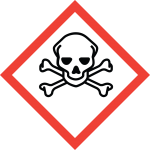Toxic Chemicals Found in Fragrance
Exactly what are the fragrance industry’s standards of safety?
The term “fragrance” represents a chemical cocktail that can be made up of hundreds of ingredients. Fragrances are found in thousands of consumer products from cleaners to tampons, yet there are very few regulations over the ingredients used in fragrance. The current system for fragrance safety is run entirely by the fragrance industry — and this self-regulating program is greenlighting chemicals that reputable authoritative bodies and government agencies have restricted, banned or deemed hazardous.
 |
| Skull and Crossbones pictogram GHS06 |
 |
| Human Hazard pictogram GHS08 |
Fragrance Chemicals and Hazard Warnings
The Globally Harmonized System of Classification and Labeling of Chemicals (GHS) is an internationally agreed-up on system, which clarifies the hazard classification of individual chemicals. A review of UN GHS classifications of fragrance chemicals finds that:
- 190 fragrance chemicals have been assigned the signal word “danger” for their Safety Data Sheet.
- 1,175 fragrance chemicals have been assigned the signal word “warning”.
- 44 fragrance chemicals require pictogram GHS06 of a skull and crossbones to indicate acute toxicity.
- 97 fragrance chemicals require pictogram GHS08 indicating the chemical is a hazard to human health
Fragrance Chemicals with International Warnings
Fragrance chemicals can be found on authoritative lists (that is lists that have been recognized by regulating bodies) of toxic chemicals around the world.
- 5 fragrance chemicals are included in the National Toxicology Programs 13th Report on Carcinogens
- 7 fragrance chemicals are classified as carcinogens in the IARC Monographs
- 11 fragrance chemicals are California Proposition 65 Carcinogens and Reproductive Toxicants
- 15 fragrance chemicals are on the Washington State Chemicals of Concern to Children list
- 4 fragrance chemicals are on the EU Endocrine Disruptors Priority List
- 15 fragrance chemicals are prohibited from use in cosmetics in the EU (EU Annex ii)
- 29 fragrance chemicals are designated Toxic Substances in South Korea
- 35 fragrance chemicals are on the Canadian Cosmetic Ingredient HotList
- 6 fragrance chemicals prohibited for use in cosmetics in Canada
- 29 fragrance chemicals restricted for use in cosmetics in Canada
In addition, chemicals in fragrance are also found on lists of chemicals of concern, including the following:
- 3 fragrance chemicals are found on the EU Substances of Very High Concern
- 54 fragrance chemicals on the California Department of Toxic Substances Control Candidate Chemical List
- 31 fragrance chemicals are on the ChemSec SIN List
Learn more about the failings of the fragrance industry’s self-regulated safety program – click here.




Thank you for posting this. I have been allergic or sensitive to most fragrances for many years. It’s now very obvious to me, why. If there are that many unregulated chemicals just in fragrances it makes me very cautious as to what else is causing so many problems for so many people. No wonder we have such increases in asthma, autism and autoimmune diseases.
Most people I talk with have an issue with fragrance. “I have to move in the theater because someone sits beside me with fragrance.” ” I stepped on the elevator and two men where there. They had on some kind of horrible smelling scent.” “We had to put a note on my husband’s hospital door. Do NOT Enter if you are wearing a scented product. But many of the staff came in anyway. I had to wear a mask while caring for my husband.”
Some people just don’t know how harmful these chemicals are to themselves and to others.
I am an advocate for clean indoor air, so I talk about it all the time to other people, and found many, many have breathing problems, asthma, and coughing due to fragrances women and men wear and to all the air fresheners used in business offices and homes.
This is a very informative post. Thanks for sharing. It’s really helpful to be aware of the chemicals that may be found in fragrances. People should be aware of the things that can harm them and if possible, check out options that are more sustainable and works effectively without harmful side effects.
I found this interesting: http://www.pgproductsafety.com/productsafety/ingredients/Perfume_and_Scents.pdf. Click on the url to see NINETEEN PAGES of possible ingredients used in P&G’s products (including hundreds of synthetic chemicals), over 2,400 different substances. Any combination of these can be put into a product and lumped into the “fragrance” category. The manufacturers are not required to list them on the product, nor make them easily identifiable for consumers.
From Canada
Environmental Health Association of Ontario
http://ehaontario.ca/help-with.html
Health Risks of Fabric Softeners
© Echo/Ecological Housing, 1998
There are many potentially dangerous products used in the home. To list the
chemicals in each of them and the health risks for each of these would produce a
truly huge volume. We have chosen fabric softener as the prime illustrative
example for a number of reasons.
It is the most toxic product produced for daily household use. It has been
found to be associated with numerous illnesses and chronic conditions.
1. It is widely advertised, widely used.
2. The effects of its toxicity are insidious; a user becomes
“chronically maladapted” to it. The exposure is so constant
that it can be difficult to connect the product with the signs
of reactivity it causes. Neurostimulant/irritants and
central nervous system toxins used in these products
are known to produce an addictive-type response that may
cause the user to experience a feeling of pleasure when
the product is directly inhaled. Regular users of fabric
softeners (and perfumes) also often claim they “can hardly
smell it”. This too is an effect of chemical ingredients on
neural receptors.
3. The product is designed to impregnate fibres and slowly rerelease
for an extended period of time. That re-releasing
affects the health not only of users, but those around
them.
The following information contains a partial list of the chemical ingredients of fabric softeners and
the potential effects of exposure to them as quoted from manufacturers’ Material Safety Data
Sheets. For the purposes of this document, Central Nervous System has been abbreviated to CNS.
CNS toxin exposure symptoms include: dizziness, disorientation, nausea, headaches, mood
swings, numbness in face or extremities, pain in neck or spine, memory loss, aphasia (difficulty
speaking), confusion, irritability. CNS disorders include: Alzheimer’s, Parkinson’s, Dementia,
Seizures, Multiple Sclerosis, Multiple Chemical Sensitivity, Hyperactivity, Strokes, Attention Deficit
Disorder, Sudden Infant Death Syndrome.
A good alternative to fabric softener or fabric softener sheets is a piece of aluminum foil.
2
Risks of Perfumes and Scented Products
The chemicals listed on the following page (along with Methylenechloride, Ethanol, Formaldehyde,
and other petrochemicals and neurotoxins) are among the 4,000 chemical ingredients used in the
manufacture of perfumes and scents. The Environmental Protection Agency (E.P.A.) collected
samples of every perfume sold in North America in 1993. Every sample contained Toluene (a
proven carcinogen and neurotoxin designated as Hazardous Waste worldwide). Many also
contain chemicals to mimic the pheronones (sex hormones) of insects, musk ox, apes, and
pigs. (Sounds romantic, doesn’t it) The health risks of these products are so varied and extreme it
almost defies comprehension.
Chemical Ingredients in Fabric Softeners/Dryer Sheets:
Alpha-Terpineol: “Causes CNS disorders. Highly irritating to mucous membranes. Aspiration into
lungs can produce pneumonitis or fatal edema. Lesser exposures can cause decreased circulation,
headache, depression of CNS and/or respiratory function, ataxia (loss of muscle coordination),
behavioral changes. Prevent repeated or prolonged skin contact.”
Benzyl Acetate: “Carcinogenic. Vapors irritating to eyes and respiratory passages, exciting cough.
In mice, pancreatic cancer, hyperanemia of the lungs. Can be absorbed through skin causing
systemic effects. Do not flush to sewer system.”
Benzyl Alcohol: “Associated with CNS disorders. Irritating to upper respiratory tract. Can cause
headache, nausea, vomiting, dizziness, sudden drop in blood pressure, CNS depression, death due
to respiratory failure.”
Camphor: On E.P.A.’s Hazardous Waste list. “Avoid contact with eyes, skin, clothing. Do not
breathe vapours. Inhalation can be fatal. Properties: anesthetic, neurotoxic, carcinogenic. Chronic
effects of exposure may include liver and/or kidney damage. Medical conditions aggravated by
exposure. Kidney disorders, liver disorders, heart disorders, skin disorders, allergic or respiratory
conditions. May cause headache, nausea, vomiting, dizziness, drowsiness, irritation of respiratory
tract, loss of consciousness. Conditions to avoid: heat”.
Ethyl Acetate: On EPA.’s Hazardous Waste list. “Narcotic, may cause headache, narcosis, stupour.
Irritating to eyes and respiratory tract. May cause anemia with leukocytosis and damage to liver and
kidneys. Wash thoroughly after handling.”
Limonene: “Prevent contact with skin or eyes. Properties: irritant, sensitizer, carcinogenic. Always
wash thoroughly after using, especially before eating, drinking, applying cosmetics. Do not inhale.”
Linalool: “Narcotic. Associated with CNS disorders and respiratory disturbances. Attracts bees. In
animal testing: ataxic gait, reduced spontaneous motor activity and depression, depressed heart
activity, development of respiratory disturbances leading to death.”
Pentane: “Danger: Harmful if inhaled. Inhalation of vapor may cause headache, nausea, vomiting,
dizziness, irritation of respiratory tract and loss of consciousness. Contact can cause eye or skin
irritation.”
Thank you very much for all this information regarding the dangers and harmful effects of chemicals that are abused .
Limonene is not a carcinogen. In fact, it has anti-cancer affects in some cases. (Standard disclaimer: I’m not a doctor and this isn’t medical advice.) I really hate scare disinformation. https://www.ncbi.nlm.nih.gov/books/NBK402143/#_p307_s3_
But I react to synthetic limonene at differing levels, I presume depending upon the level of impurity. On a scale of one to ten, it’s anywhere from a 5 to 8 for me with 8 being very tired, largely disoriented, confusion, brain “blanking”, a sort-of stunned reaction. iiuc, the synthetic crap is derived from petroleum chemicals.